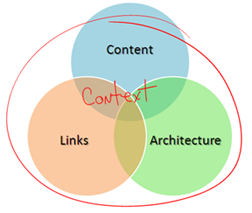In a previous article I talked about the 3 C’s of Marketing as explained at John Jantsch’s Duct Tape
Marketing.
However, in a recent business meeting, an associate explained their 3 C’s as the following (which was remarkably similar): Content, Context, and Community. I have to say that this resonated with me much more than the other version.
Context
In the first article, it was Content, Contact and Community. The difference is context, which is something that has come around more than once in my writing, analysis, and observation. In my opinion, context is quickly becoming the authority for many aspects of web marketing; as one example, it is changing the field of search engine optimization from rote tasks to truly understanding the site visitor and persuasively presenting the site to them, rather than simply targeting random high-volume words for search engine rankings.
Links and content, by themselves, are the building blocks of a website, but it is the context of both that determines true relevance to a visitor and to a search engine. The context of words on the page is as important as the words themselves. Links are incredibly important, but the context of the link can increase sales, damage a reputation, build relevance in the search engines, or attract a click-through from a searcher.

Essentially, it distills down to a few simple principles of community. The concept of Web 2.0 is successful because it focuses on a community to create content within a strong context.
Context of the Community
While the social media new sites, such as Digg, can create impressive traffic spikes, there is very little common context among the visitors that come to a website from the social news site. The context increases with search traffic, as people are looking for information concepts, and they may find the information on your site. Context increases firther for visitors from related subject forums and industry publications. From continuing analysis of website traffic, the highest levels of visitor engagement are recorded by visitors from blogs. Blogs are especially effective as blogrolls, interlinking, and cross posting create a high level of context within a community that is typically built around a specific niche. A “contextual community” as I have been calling it.
In the contextual community, there isn’t a high level of competition for the reader’s attention. Links are within the context of a “conversation” with only a few selected blogs or publishers, and they are usually relevant to the common context. This is why visitors from blogs are engaged at such a high level. When they follow a link to a new blog or a website – other than a friend’s email, it is the closest thing to a true word-of-mouth referral online.
The bottom line is Content. (links are content as well)
Context of Content
Content is not equal. The same content on a webpage can be irrelevent and valuable at the same time, depending upon who reads it. The value of content is determined by the community and context in which it is presented. This is why directories have become almost useless, even irrelevant, with the increase of blogging – the community has migrated.
Amazingly, old-fashioned marketing principles apply, grow what works. Find your audience and build a conversation with them. If an event happens that gives you instant popularity, such as getting on Digg – ride the wave, have fun. However, be warned that trying to duplicate the wave without first building your contextual community will only provide very short-term results. Ultimately, you need to know your audience, invest in the community, and be a trusted source of information.
Related Posts:
Social Media Under the Microscope

Hi there,
Interesting read indeed.
While reading a question came to mind.
In a situation where a company has an eCommerce site.
What part of the the SEO, traffic generation is marketing and what part is sales’ job – best practices…
The predicament is that in eCommerce SEO is a strategy to generate sales (responsibility?) so is affiliate “marketing”. The context here is a mature and structured organisation.
L8r!